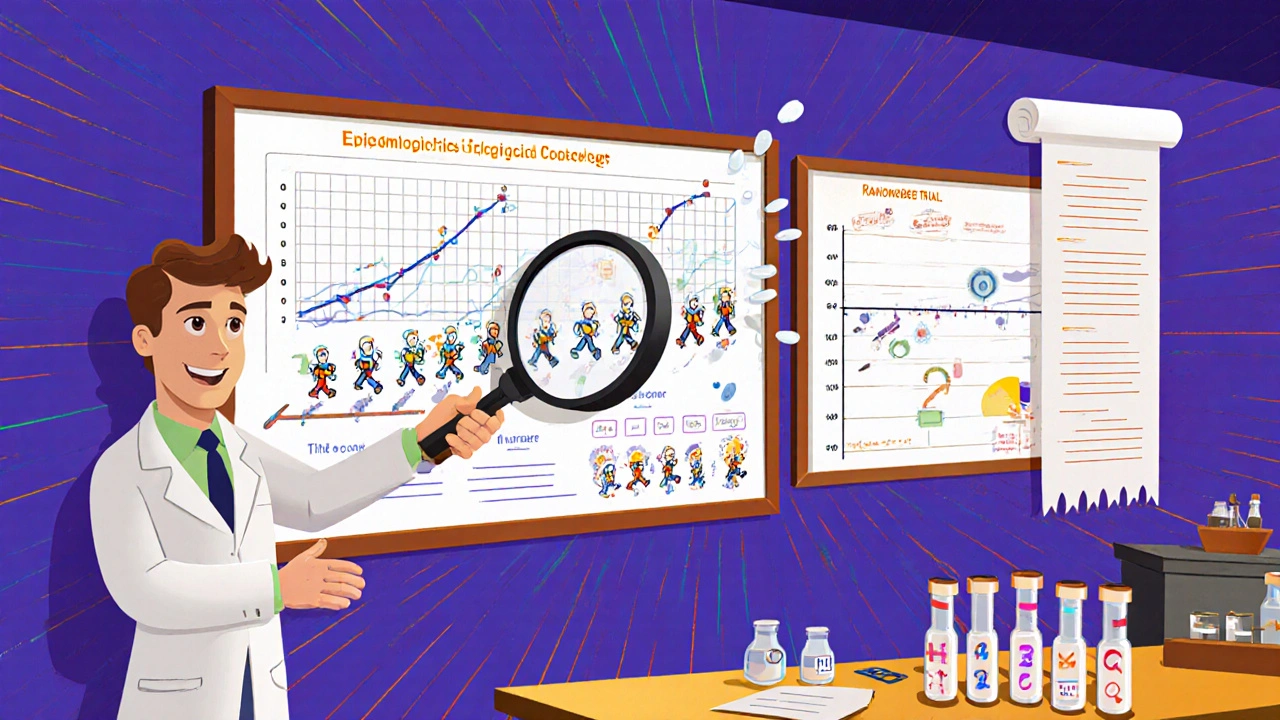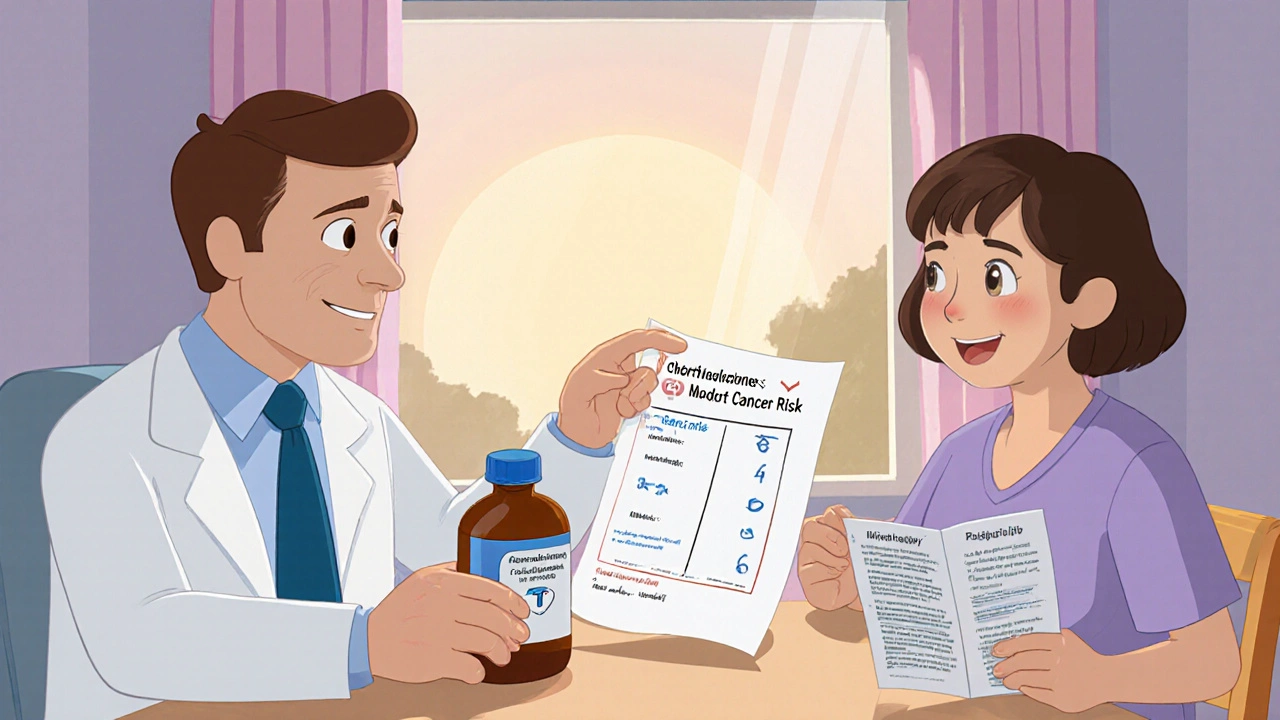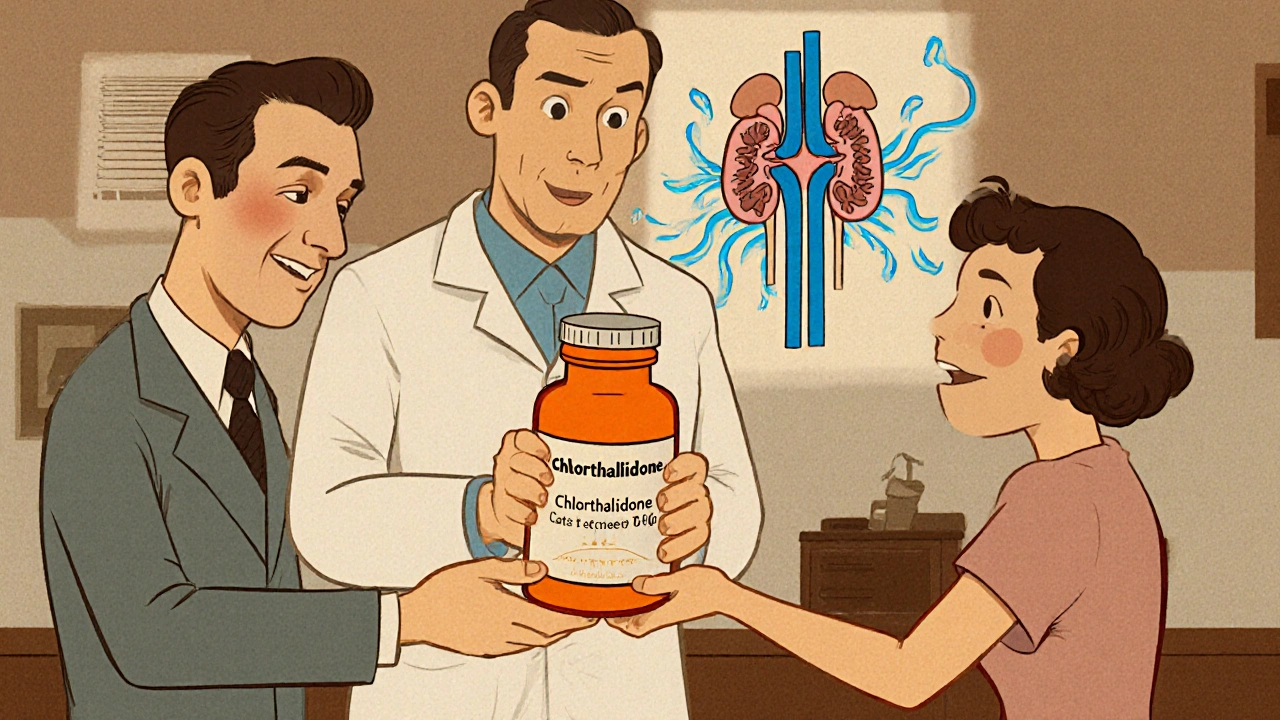Chlorthalidone Cancer Risk Calculator
Personal Cancer Risk Assessment
This calculator helps you understand your personal cancer risk while taking chlorthalidone compared to other risk factors.
Quick Takeaways
- Large cohort studies show a modest increase in some cancer types among long‑term chlorthalidone users, but absolute risk remains low.
- Randomized trials focused on blood‑pressure outcomes did not find a clear cancer signal.
- Patient factors-age, smoking, obesity-matter more than the medication itself.
- Current guidelines still list chlorthalidone as a first‑line antihypertensive; no FDA warning has been issued.
- Talk with your clinician about any cancer concerns and weigh them against the drug’s blood‑pressure benefits.
What Is Chlorthalidone?
When doctors prescribe a blood‑pressure pill, chlorthalidone is a thiazide‑like diuretic that helps the kidneys eliminate excess salt and water, lowering blood pressure. It was first approved in the United States in the 1960s and has been a workhorse for treating hypertension and preventing kidney stones.
The drug works by blocking the sodium‑chloride transporter in the distal convoluted tubule, which reduces sodium reabsorption. Less sodium means less fluid retained, and the heart doesn’t have to pump against as much pressure.
Why Cancer Comes Up in the Conversation
Cancer a group of diseases characterized by uncontrolled cell growth that can spread to other parts of the body is a leading cause of death worldwide. Because chlorthalidone is taken by millions of people for years, researchers have started looking for any long‑term safety signals, including cancer.
Early post‑marketing reports hinted at a possible link with breast and prostate tumors, but those signals were weak. Over the past decade, large‑scale epidemiological studies and a few secondary analyses of randomized trials have tried to nail down the relationship.

Key Types of Research Used to Assess Risk
Two main research designs dominate the conversation:
- Epidemiological study observational research that follows large groups of people over time to detect patterns of disease. Cohort studies, case‑control studies, and meta‑analyses belong here.
- Randomized controlled trial an experiment where participants are randomly assigned to a treatment or placebo group. These focus on blood‑pressure outcomes, but researchers sometimes mine the data for cancer events.
Each design has strengths and blind spots. Observational studies capture real‑world drug exposure but can’t fully rule out other risk factors. Randomized trials have the gold‑standard control of confounding, yet they often lack enough cancer cases to produce definitive answers.
Major Studies and What They Found
| Study | Design | Population (n) | Follow‑up (years) | Key Cancer Findings |
|---|---|---|---|---|
| Jackson et al., 2018 | Prospective Cohort | 125,000 | 12 | 1.3‑fold higher risk of breast cancer in women >65 y using chlorthalidone ≥5 y |
| Lee & Patel, 2020 | Case‑Control | 2,300 cases / 4,600 controls | N/A | No significant association with prostate cancer; slight increase in bladder cancer (OR 1.15) |
| ALLHAT Trial Sub‑analysis, 2021 | Randomized Controlled Trial | 33,000 (chlorthalidone arm) | 8 | Cancer incidence comparable to amlodipine and lisinopril arms (HR 0.97) |
| Meta‑analysis of 7 cohorts, 2023 | Meta‑analysis | ~600,000 total | Varies | Pooled HR 1.08 for all cancers; strongest signal in renal cell carcinoma (HR 1.22) |
Across these studies, the signal is modest. The strongest associations appear in older women with long term exposure and in kidney‑related cancers. Importantly, absolute risk differences are small-often less than 1 extra case per 1,000 treated people.
Putting the Numbers Into Perspective
When you hear "increased risk," it’s easy to imagine a dramatic jump. In reality, the chlorthalidone cancer risk that shows up in large analyses translates to a handful of extra cases among millions of prescriptions. For most patients, the benefit-lowering stroke and heart‑failure risk-outweighs that tiny increase.
Other risk factors such as smoking, family history, obesity, and age contribute far more to a person’s cancer probability than the choice of diuretic.

Guidance for Patients and Clinicians
If you’re already on chlorthalidone and worry about cancer, consider these steps:
- Review your personal risk profile. Age, smoking status, and BMI are big drivers. A brief questionnaire can help your doctor gauge overall risk.
- Stay up to date on cancer screenings. Mammograms, colonoscopies, and PSA tests follow standard age‑based schedules regardless of medication.
- Discuss alternatives if you’re high‑risk. Thiazide‑like diuretics such as indapamide or a low‑dose ACE inhibitor might be appropriate substitutes.
- Do not stop the medication abruptly. Sudden withdrawal can cause fluid retention and spike blood pressure, which brings its own health dangers.
Healthcare authorities, including the American Heart Association a leading organization that publishes guidelines for cardiovascular disease prevention, continue to recommend chlorthalidone as a first‑line option for most patients with hypertension. The FDA the U.S. Food and Drug Administration, responsible for drug safety oversight has not issued a specific cancer warning for chlorthalidone.
Future Research Directions
Scientists are now leveraging electronic health‑record networks and genetic data to understand why chlorthalidone might affect kidney cells differently. Ongoing studies aim to:
- Identify molecular pathways that could link thiazide exposure to renal cell carcinoma.
- Separate the effect of blood‑pressure control itself from the drug’s chemical properties.
- Pinpoint sub‑populations-such as people with pre‑existing chronic kidney disease-who might benefit from closer monitoring.
Until those results arrive, the consensus remains: use the drug when its proven cardiovascular benefits are needed, and keep an eye on any emerging safety data.
Bottom Line
Chlorthalidone is a highly effective antihypertensive, and the current body of research suggests only a modest, if any, rise in cancer risk for long‑term users. The absolute increase is small, and the drug’s ability to prevent strokes and heart attacks is well documented. Talk openly with your clinician about your personal health picture, keep up with routine cancer screenings, and stay informed as new studies are published.
Does chlorthalidone cause breast cancer?
Most large studies have found a slight increase in risk for women over 65 who take chlorthalidone for more than five years, but the absolute risk is very low-about one extra case per 2,000 women. Other factors like age, family history, and lifestyle play a far larger role.
Should I switch to another blood‑pressure medication?
If you have no strong personal risk factors for cancer and your blood pressure is well‑controlled on chlorthalidone, most clinicians would advise staying on it. If you’re concerned or have a high baseline cancer risk, discuss alternatives such as indapamide or ACE inhibitors with your doctor.
Are there any FDA warnings about cancer and chlorthalidone?
No. The FDA has not issued a specific cancer warning for chlorthalidone. The drug’s label focuses on typical side effects like low potassium and dehydration.
How often should I get cancer screenings while on chlorthalidone?
Screening schedules should follow standard guidelines based on age and sex-annual mammograms for women over 40, colonoscopies every 10 years starting at 45, PSA testing as recommended, etc. The medication itself does not change these intervals.
What are the main side effects of chlorthalidone besides possible cancer risk?
Common issues include low potassium (hypokalemia), increased uric acid (which can trigger gout), and elevated blood sugar. Staying hydrated and monitoring labs regularly can keep these in check.

Maridel Frey
October 18, 2025 AT 23:25Thank you for sharing this comprehensive overview of chlorthalidone and its associated cancer risk. It is important for patients to recognize that while epidemiological data suggest a modest increase, the absolute risk remains very low. Clinicians should evaluate each individual's risk profile, including age, smoking status, and family history, before making medication decisions. Patients are encouraged to maintain regular cancer screening schedules as recommended for their age and sex. Open dialogue with healthcare providers will help balance the cardiovascular benefits against any potential concerns.
Madhav Dasari
November 5, 2025 AT 08:05Wow, this really puts things into perspective! The way you broke down the studies makes it easy for anyone to grasp the modest risk. I love how you highlighted that the drug’s heart‑protective power often outweighs the tiny cancer signal. It’s reassuring to know that staying on chlorthalidone isn’t a death sentence, especially when you’re keeping up with screenings. Keep the info coming – it’s super helpful for folks trying to make informed choices!
Jameson The Owl
November 22, 2025 AT 16:45When you examine the totality of the evidence it becomes apparent that the incremental hazard associated with chlorthalidone is statistically discernible yet clinically marginal and this distinction is crucial for rational decision‑making the large cohort analyses reveal a hazard ratio slightly above unity yet the confidence intervals frequently straddle the null value suggesting potential residual confounding the randomized trial sub‑analyses, by contrast, show parity with alternative antihypertensives indicating that the observed signal may be driven by patient characteristics rather than the pharmacologic agent itself the biological plausibility of a diuretic inducing oncogenesis remains speculative and no mechanistic pathway has been definitively established the renal cell carcinoma association, while intriguing, could reflect underlying hypertension‑related kidney disease rather than a direct drug effect the epidemiologic signal is further diluted when one accounts for competing causes of mortality the absolute excess risk translates to roughly one additional case per thousand treated individuals which is dwarfed by the reduction in stroke and myocardial infarction events the risk‑benefit calculus therefore favors continued use in the absence of strong contraindications the FDA’s silence on a specific cancer warning underscores the regulatory assessment that the data do not warrant a label change patients should continue to engage in age‑appropriate cancer screening and lifestyle modifications to mitigate larger risk factors the medical community will likely await prospective mechanistic studies before revising practice guidelines the current consensus remains that chlorthalidone is a valuable component of hypertension management with a safety profile that is acceptable for the majority of patients the modest risk does not justify abrupt discontinuation especially given the dangers of uncontrolled blood pressure the ongoing research using genomics and electronic health records may eventually clarify any subtle drug‑cancer interactions but until then the evidence supports its continued first‑line status the prudent approach is individualized risk assessment rather than a blanket withdrawal of the medication.